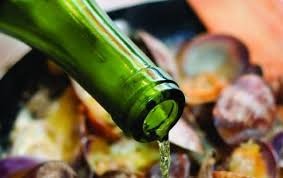|
Getting your Trinity Audio player ready...
|
Full Text
A Facebook user identified as Ewere Obi uploaded a video showing her preparing food with several brands of alcoholic beverages. The video, as of Oct. 18, 2025, had gained over 36,200 views, 3,500 likes, and 2,000 shares.
The post generated mixed reactions in the comments section. One user, Theodora Ado, wrote, “Sickness when go plenty later eh… No be small o… I swear.. Christ.”
Another user, Godwin Monday, commented, “Na lie… but wait, can heat boil alcohol in that way??? Your liver and kidney go dey pray make their creator remove them from you.”
Charlotte Amelia added, “Tomorrow, you will start complaining of a kidney problem, hmmm, well done.”
Meanwhile, some users argued that heating alcohol neutralises its intoxicating properties.
Theo Theo Tladi stated, “Boiling or simmering alcohol mixed with other liquids neutralises the alcohol effects so you won’t get drunk like you hope, but your food can become a little bitter.”
Beatrice Nelson also noted, “All the alcohol, the moment it’s on fire, it reduces its highness.” Another commenter, Wood Toritse Effuah, jokingly asked, “No be the abortion pepper soup way dem dey talk about be dis?”
DUBAWA, considering the concerning practice being promoted and the varying views about it, decided to write an explainer article.
What is Alcohol?
According to the World Health Organization (WHO), alcohol, specifically ethanol, is a psychoactive and toxic substance found in alcoholic drinks such as beer, wine, and spirits. It is produced by fermenting sugars from fruits, grains, or other plant materials with yeast.
The WHO reports that alcohol consumption contributes to 2.6 million deaths globally every year and is responsible for 4.7% of the global burden of disease. The organisation added that the harmful use of alcohol is a leading risk factor for premature death and disability among individuals aged 20 to 39 years, accounting for 13% of all deaths in that age group.
The organisation further notes that alcohol plays a causal role in more than 200 diseases and injuries, including liver cirrhosis, heart disease, and several types of cancer. Vulnerable populations are often more affected, with higher rates of alcohol-related illnesses and hospitalisations.
Is cooking with Alcohol safe?
The Times of India reports that alcohol can significantly enhance the flavour of food. It is a versatile ingredient that not only tenderises meat but also deepens a dish’s flavour profile. When used in small amounts, alcohol contributes minimal calories. The report further notes that alcohol molecules can bond with both fat and water, enabling them to carry and release complex aromas that enhance the overall flavour experience.
However, alcohol in cooking is not suitable for everyone. Pregnant women and children are more sensitive because their bodies process alcohol differently. Similarly, people recovering from alcohol addiction, as well as those with liver conditions or taking alcohol-interacting medications, should avoid it.
Public health agencies such as the U.S. Centres for Disease Control and Prevention (CDC) maintain that no amount of alcohol is completely safe, particularly during pregnancy. The World Health Organization (WHO) also warns that long-term alcohol exposure, even in small doses, can heighten the risk of liver disease and certain cancers.
Moreover, there are fire safety risks associated with cooking with alcohol. The National Fire Protection Association (NFPA) cautions against pouring alcohol directly into a hot pan or over open flames, as this can cause dangerous flare-ups or burns. It recommends handling alcohol with care around heat sources.
Does cooking eliminate alcohol from food?
Studies by the United States Department of Agriculture (USDA) show that alcohol does not completely evaporate during cooking. The amount that remains depends mainly on the cooking method, temperature, and duration of heat exposure.
According to the study, if alcohol is added to boiling liquid and removed immediately from the heat, up to 85% of it remains in the food. In dishes where alcohol is flambéed (set on fire), about 75% is retained. The study notes that when the dish is simmered or baked for 1 hour, the retention rate drops to around 25%, and after 2.5 hours of cooking, approximately 5% of the alcohol remains.
What Experts Say
A South African-based dietitian, Emmanuel Oyebamiji of the University of KwaZulu-Natal, said that most viral videos showing people cooking with alcohol are created for social media attention rather than for healthy cooking.
He explained that alcohol helps extract flavours from food by dissolving fat- and water-soluble compounds, which can enhance the aroma and complexity of dishes such as sauces, marinades, and stews.
However, Oyebamiji warned that the assumption that alcohol burns off completely during cooking is misleading.
“People believe alcohol disappears when heated, but that is not true. After cooking, some of the alcohol remains, meaning those who eat such food are still consuming alcohol,” he said.
He also noted that alcohol provides about seven kilocalories per gram, which can impact metabolism and general body function. According to him,
“This can be risky for children, pregnant women, individuals with liver disease, or those recovering from alcohol addiction, as it can interfere with blood sugar regulation and interact with certain medications.”
Oyebamiji further cautioned that social media users promoting such cooking trends might be “unknowingly harming themselves” and could face adverse health outcomes in the long run.
Similarly, Jeremiah Silas, a higher dietitian, said even small retained amounts of alcohol can cause metabolic and liver stress.
He explained that alcohol, even in trace quantities, places additional pressure on the liver, especially for people suffering from fatty liver disease, hepatitis, or metabolic disorders.
Silas also highlighted the potential for sensitivity or allergic reactions to compounds like sulfites and histamines, which are commonly found in wines and beers used for cooking. These can trigger headaches, skin flushing, or inflammation in sensitive individuals.
Conclusion
Cooking with alcohol may improve the taste and aroma of food, but it is not without health risks. Scientific evidence shows that alcohol is never entirely removed through heat, and consuming such meals exposes the body to residual amounts that may strain vital organs over time.







